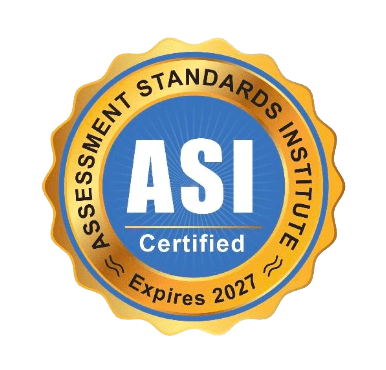TC Research Précis
The purpose of this page is to provide key information regarding the research for the True Colors methodology and the True Colors assessment process. The Assessment Standards Institute (ASI) completed an extensive assessment of the True Colors methodology and Online Assessment. Below are their findings.

"This certifies third-party evaluation of the True Colors assessment product, and that the assessment exceeds generally accepted standards of Data Reliability, Construct Validity and Disparate Impact as measured by the EEOC 80% Guideline.”
The True Colors instrument, and most similar instruments, are ipsative in design. That is, they are self-report inventories that measure qualities (traits) as individuals perceive those traits within themselves, and they ask the respondent to choose one trait at the exclusion of the others. This is done via either/or, most/least, or rank-order responses to the instrument.
The result is not an absolute set of scores that would easily fit in a normative field, but rather a relative set of scores that applies to an individual's self-perception. The success of all self-report instruments depends on the insight, candor, honesty, and insight of the respondent.
The population sample size for this study was 10,000 (N=10,000).
Data Reliability
The reliability of the True Colors instrument was evaluated with the use of a Cronbach’s alpha. This technique is regarded as one of the most robust measures of reliability and presents the highest 'bar' from which to compare. The readers should note that Cronbach's alpha is the method selected by HRD Press authors and researchers for this instrument, because of its high standards. The reader is encouraged to compare reliability coefficients presented herein to other vendors, and also to ask those vendors who reliability formulas they used to compute their reliability coefficients.
A portion of the in-depth report from ASI reads: “The review team at ASI applauds the instrument design team at True Colors for the exceptionally high Cronbach’s Alpha scores achieved in our review.
All four themes present in the Very Good to Excellent ranges, and we do not experience this consistently high level of alpha scores in many of the instruments that we review. These numbers indicate the precision by which the True Colors instrument design team engaged in order to produce these levels.”
Construct Validity
This is one of the most central concepts in psychology. It is the degree to which a test measures what it claims, or purports to be measuring. Researchers generally establish the construct validity of a measure by correlating it with a number of other measures and arguing from the pattern of correlations that the measure is associated with these variables in theoretically predictable ways. Overall, it is the appropriateness of inferences made on the basis of observations or measurements (often test scores), specifically whether a test measures the intended construct. Constructs are abstractions that are deliberately created by researchers in order to conceptualize the latent variable which is correlated with scores on a given measure although it is not directly observable).
Construct validity examines the question: Does the measure behave like the theory says a measure of that construct should behave? Correlations; the purpose of a correlation is to display the level or correspondence or corelationship between two variables. An item or trait correlated against itself yields a perfect correlation of 1.0, that's as high as the scale goes. A completely opposite correlation yields a coefficient of -1.0, and that's a perfect inverse or negative correlation. Scores that have no co-relationship at all, show a correlation coefficient at or near zero.
Disparate Impact
What is Disparate Impact? Employers often use tests and other selection procedures to screen applicants for hire and employees for promotion. The use of tests and other selection procedures can be a very effective means of determining which applicants or employees are most qualified for a job. However, use of these tools can also violate the federal anti-discrimination laws if they disproportionately exclude people in a protected group by race, sex, or another covered basis.
The following is a summary statement from ASI. “Looking at the combined results of your analysis, the overall quality of your assessment is excellent. You should be incredibly pleased with your results. Please share the accompanying reports with pride to your customers and clients.”
